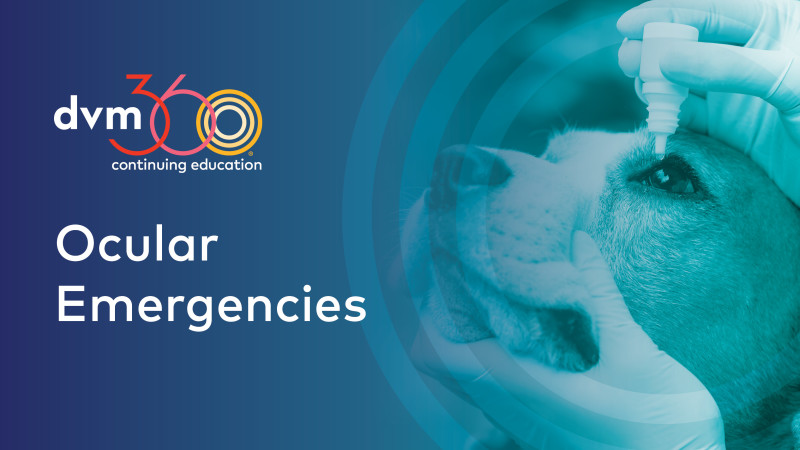Continuing Education
1-Hour Course
Course Overview: This presentation will be an in-depth discussion on tear film, dry eye disease and its effect on the eye, diagnosis, and medical treatment of quantitative and qualitative dry eye disease.
Caroline Betbeze — DVM, MS, DACVO
Dr. Betbeze is a diplomate of the American College of Veterinary Ophthalmologists (ACVO) and an associate clinical professor of comparative ophthalmology at Mississippi State University College of Veterinary Medicine, her alma mater.
 Lionel Sebbag, DVM, PhD, DACVO
Lionel Sebbag, DVM, PhD, DACVODr. Sebbag obtained his veterinary medical degree (DVM) from the National Veterinary School of Toulouse (France). He then completed a rotating Internship at Kansas State University before pursuing a 4-year Residency in Comparative Ophthalmology at the University of California-Davis. After his residency training, Dr. Sebbag went to Iowa State University to complete a Ph.D. in Biomedical Sciences focused on pharmacology and ocular disease models. He now works as a faculty member in Ophthalmology at the Koret Veterinary School in Israel. His clinical and research interests include ocular surface diseases, tear film biology and innovations in drug delivery to the eye.
Clinical Management of Corneal Ulcers – Simple vs. Complicated
1.0 CE Credit Hour / Veterinarians & Veterinary Technicians
Learning Objectives:
- Recognize the different types of corneal ulceration in domestic animals
- Understand the potential causes for corneal ulceration in domestic animals
- Understand common pitfalls of corneal ulcer management in private practice
- Learn how to appropriately manage a superficial non-infected corneal ulcer (simple ulcer)
- Recognize the main reasons for inappropriate healing of corneal ulceration in domestic animals (complicated ulcer)
- Learn how to appropriately manage a ‘complicated ulcer’ in domestic animals
Diagnostics in Ophthalmology: Getting the Most Out of These Minimally Invasive Tests
1.0 CE Credit Hour / Veterinarians & Veterinary Technicians
Course Overview:
Preliminary diagnostics are an important part of the ophthalmic exam in veterinary patients. Testing such as Schirmer tear test, fluorescein stain, and tonometry can greatly aid in the diagnosis of a disease present within the eyes. Also, simple procedures such as menace response, dazzle reflex, and pupillary light (PLR) reflexes can offer a great deal of insight into the prognosis of the eye condition. The discussion today will resolve around the proper way to perform these diagnostics as well as what number/values indicate normal vs. concerning results.
 Joshua J. Broadwater DVM, DACVO
Joshua J. Broadwater DVM, DACVOJoshua Broadwater was born and raised in the small coal mining town of Lonaconing, Maryland. He attended the University of North Carolina-Chapel Hill, where he studied biology and graduated with highest honors. Dr. Broadwater then attended veterinary medical school at the Virginia-Maryland Regional College of Veterinary Medicine.
 David J. Maggs, BVSc (hons), DACVO, MANZCVS
David J. Maggs, BVSc (hons), DACVO, MANZCVSFollowing graduation from the University of Melbourne in 1988, David spent 5 years in mixed practice throughout Australia, England, Scotland, and Wales. He then completed both small animal and equine internships at Colorado State University, and a research fellowship and comparative ophthalmology residency at the University of Missouri. He joined the faculty at the University of California-Davis in 2000 where he is now Professor Emeritus. He is co-author of Slatter’s Fundamentals of Veterinary Ophthalmology, which has been translated into 6 languages. Dr. Maggs’ major interests are surface ocular disease, with a particular focus on the management of dry eye disease and feline herpesvirus.
Puffy Eye… Maybe It’s Feline Herpesvirus?
1.0 CE Credit Hour / Veterinarians & Veterinary Technicians
Learning Objectives:
- To recognize the main ocular signs of FHV-1, and differentiate these from Chlamydia
- To compare the efficacy of the commonly available antiviral dugs and adjunctive care for cats with FHV-1
- To construct a rational treatment plan for the common manifestations of FHV-1
Practical Corneal Ulcer Management for General Practitioners
1.0 CE Credit Hour / Veterinarians & Veterinary Technicians
Learning Objectives:
- Review corneal anatomy and its application to understanding ulcer management
- Identify the various types of corneal ulcers and how their management differs
- Assess our use of prophylactic antibiotic therapy as it pertains to ulcer management
- Review medical vs surgical options for complicated ulcers
 Alex Sigmund, DVM, DACVO
Alex Sigmund, DVM, DACVOAlex Sigmund, DVM, is a board-certified veterinary ophthalmologist known as “The Vet Eye Guy” on Instagram and founder of Insight Veterinary Eye Care, LLC, offering continuing education and teleconsultation services. Passionate about ophthalmology, Alex engages both veterinarians and pet owners through social media, CE events, and one-on-one consultations, aiming to make every veterinarian comfortable with ophthalmic basics to improve patient care. He plans to open a private practice focusing on client experience and quality care. Alex works with exotic animals at local zoos and aquariums and has published research on topics from feline stem cell therapy to cataract surgery in raptors. He is a University of Georgia graduate and completed his residency at the University of Tennessee. His companions include Asima, an elderly dog, and King Louie, a Ragdoll cat.
Ocular Emergencies
Overview
This presentation will be an in-depth discussion of true ophthalmic emergencies along with identification, appropriate diagnostics, and treatment options.
Key Learning Objectives
- To identify and correctly treat a traumatic proptosis
- To identify and correctly treat an anterior lens luxation
- To identify an infected corneal ulcer and perform appropriate diagnostics/treatments
- To identify primary glaucoma and treat primary glaucoma appropriately
- To identify eyelid laceration and to repair laceration appropriately
- To identify corneal foreign bodies and/or corneal perforations and confidently determine next appropriate steps





